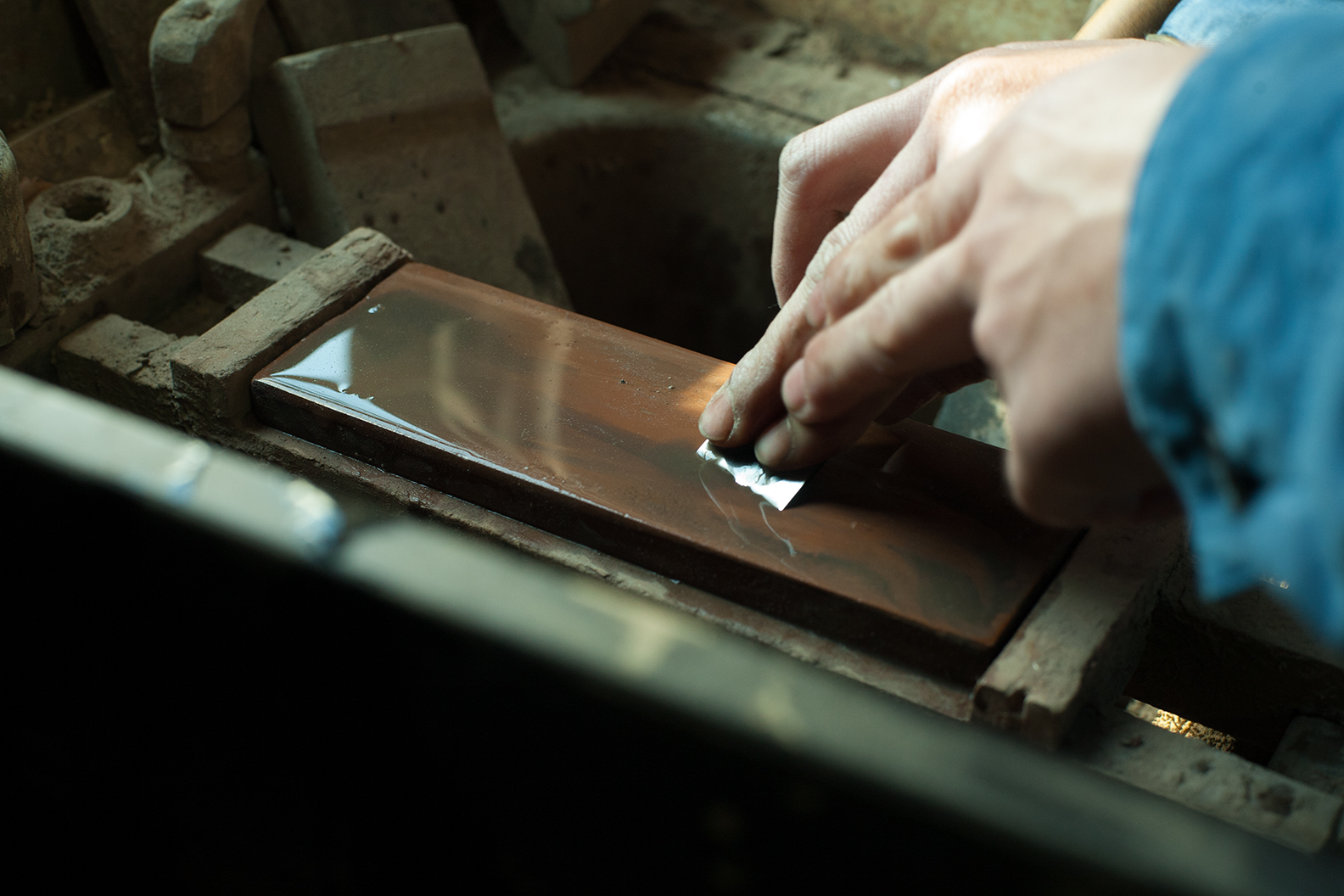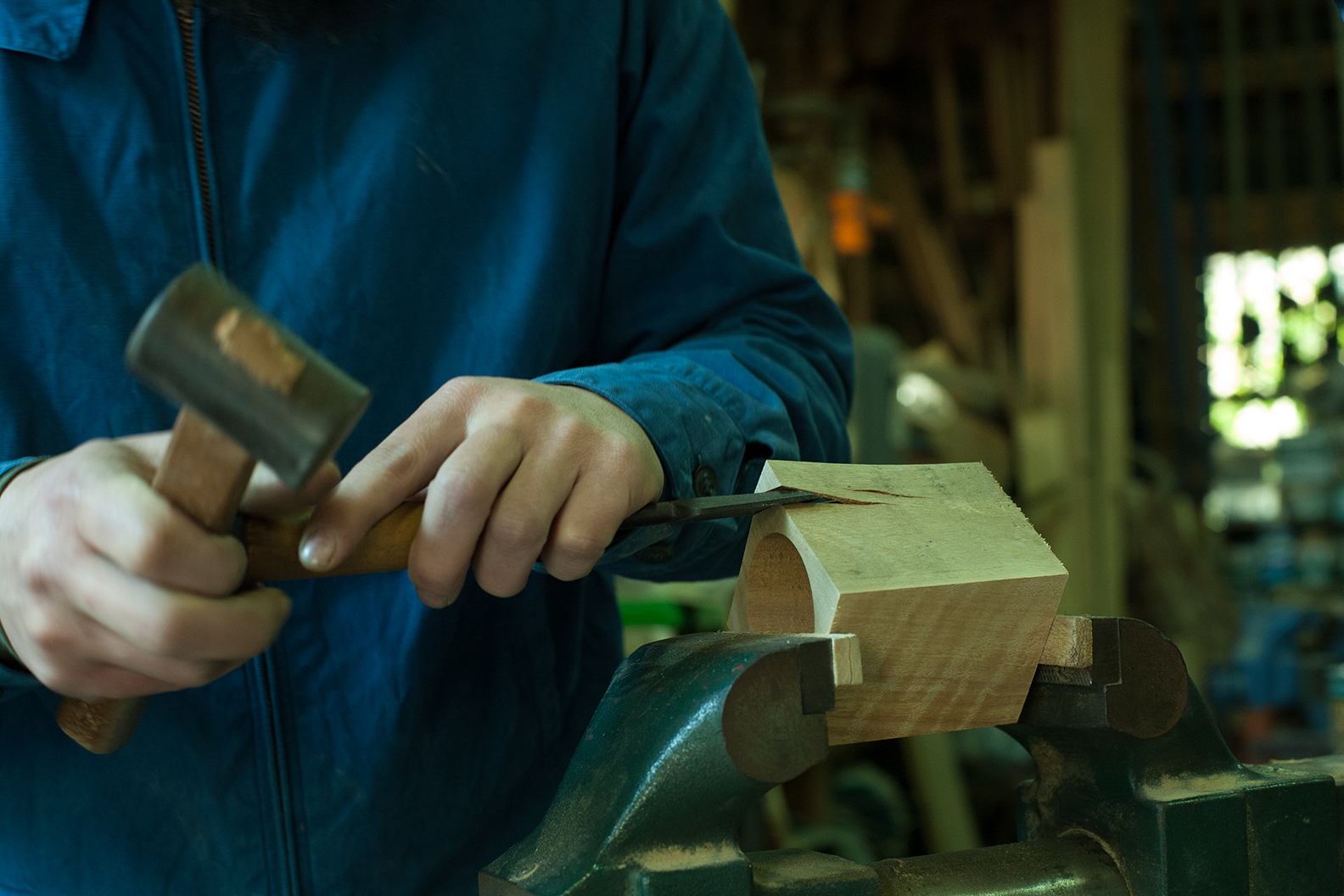
物作りの孤独という惰弱でセンチメンタルな感情はここ薩摩では感じられない。少なくとも工房
アキヒロウッドワークスにおいてそれは皆無のように感じられた。大げさかもしれないが日本を
維新へと動かした底抜けに前向きで大らかな南端の気風がここでは失われていない。
鹿児島中央駅から南西に約10キロ程のところに工房はある。どのくらいの敷地があるのだろか、
ジンくんの家族が住む母屋、両親の家、弟の家と工房が、板を横張りにしたほぼ同じ意匠の家が、
ぽつんぽつんと適度な距離感で建てられている。杉板の具合でどう云う順番で、どの程度年月に
差があるのかが凡そ判断出来る。しらきは何に比べようもなく美しい。新しい時分は凛然として
古くなれば趣きが生じてくる。そういった事を日常で感じる環境が今は少なくなってしまった。
父と子三人が一つ工房で基本的にはそれぞれの仕事をしている。もちろん困った時は互いに手を
貸し合っているようだ。おそらく自然に助け合っているのだろう。子弟、親子、兄弟という立場
と間柄の中で、樹と木工を愛する同好の士の絆、切磋琢磨する職人の絆、家族の絆とがどう云う
化学変化をしてか分からないが、工房内に於いては同志のような関係を築いているように感じた。
そこで流れる空気は美大の工房のように自由なものとも思えるのだが、その背後には『郷中』の
忠孝之道大形之無キ様相心懸クベク候
然シナガラ逃レザル儀到来候節ハ其場ヲクレ取ラザル様相働クベキ事武士ノ本意タルベキ事
のような教えと、また『南洲翁遺訓』にある実践力、
身を修し己れを正して、君子の体を具ふるとも、処分の出来ぬ人ならば、木偶人も同然なり。
いざという時にその対応が出来ることこそ人であり、後れを取らぬことが武士。という厳しさと
古風を守っているように感じた。
幾何学的な鑿目の奇麗さを意匠にした木製コップを作っているジンくんが、一つ一つ違うコップ
という海千山千會の注文に対し、出した解答は迷いのない鮮やかなものだった。荒仕事用叩き鑿
の広鑿で、四方の角を突き割っていく。今までに何万と鑿目をつけて経験してきた、﨓の木から
学んだことが広鑿の歯先に、玄翁を振る手に顕われていた。
まっこて処分のよかねぇ。
海千山千會 立沢木守
現代訳1:忠孝の道は大仰にするものではない。その旨心がけるべきであるが、必要なときには
後れを取らぬことが武士の本質である。
現代訳2:よく学んで心も正し、君子のような人物でも、何か起こった時にその対応が出来ない
人は、木で作った人形と同じだ。
198×年鹿児島県生まれ
鹿児島で木工作家として活躍する。彼の代表作は美しい鑿痕のついた大人気のJIN CUPシリーズ。
JIN CUPは木を活かした器であり商品として設計されているから、虚(うろ)とは対極のように
見えるかもしれない。しかしJIN CUPという商品の存在が無かったら、虚(うろ)もまた無いし、
石川顕さん×KIKIさんのKiKiSA KiKiLiM、Bonzaipaint®のKiTuNeLimというLiM(Less is More)の
系譜に連なった作でもある。




The weak sentiment of feeling lonely as a craftsperson does not exist in Satsuma, or at the very least,
it is so in Akihiro Woodworks Studio. This might be an exaggeration, but this place certainly has
not lost the positive and magnanimous spirit of the south that led Japan through the Meiji
Restoration in the 19th century, which restored the emperor to power.
The studio is located 10 kilometers southwest of Kagoshima Chuo Station. The main building
where the artist lives with his family is located at a comfortable distance from his studio and the two
separate houses for his parents and brother——all built on the large piece of land owned by the family.
One can tell roughly from the cedar wall panels in what order the buildings were built and how old
they are. The beauty of plain wood is truly incomparable. It is striking when it is new and develops
character as time passes. These days, it is rare to find an environment that makes me feel that way.
Father and sons work in the same studio, each pursuing their own projects. Of course, the four men
help one another if the need arises. To me, they looked like kindred spirits in the studio as I watched
them work. I wonder if it is the parent-child relationship or the fact that they are brothers that led
them to have a shared love for wood and woodcraft and have such a strong bond as diligent
craftsmen and family. The atmosphere in the studio is similar to what you may find in an art school,
where you are free to express yourself. However, I also felt that they have kept the discipline and
tradition from the old days, demonstrating the loyalty and filial piety seen in warriors in the past.
Jin creates wooden cups with beautifully geometric indentations. We always ask him to make each
cup unique, and he never fails to deliver. Using the wide tip of a chisel for rough work, indentations
slowly formed on the wood as he swiftly carves from different angles with a hammer.
By Kimamori Tachizawa
Born in Kagoshima Prefecture in 198x, he is now working as a woodcraft artist in his hometown. His leading work is the popular Jin Cup Series with beautiful wood grain.
Jin Cup is a wooden vessel and designed for commercial use, so it may seem like the complete opposite from Uro, but Uro would not have existed without Jin Cup.
It is part of the LiM (Less is More) line, which includes KiKiSA KiKiLiM by Akira Ishikawa and KIKI, as well as KiTuNeLim by Bonzaipaint®.
